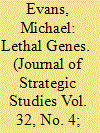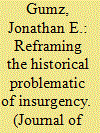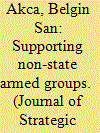|
|
|
Sort Order |
|
|
|
Items / Page
|
|
|
|
|
|
|
| Srl | Item |
| 1 |
ID:
089958


|
|
|
|
|
| Publication |
2009.
|
| Summary/Abstract |
After September 11, 2001, President George W. Bush's administration presented a national security agenda that held two key goals: the denial of safe havens to terrorist groups with international reach, and the prevention of terrorist groups from acquiring Weapons of Mass Destruction (WMD). In 2002, a terrorist group, Ansar al-Islam, operating out of a camp in Khurmal, northeast Iraq, was reportedly developing cyanide gas, toxic poisons, and ricin for potential use against Europe and the United States. The Joint Chiefs of Staff unanimously supported, and formally presented to the White House, a military operation to destroy the Ansar camp. This article, based on research and interviews with senior military and civilian officials, assesses four plausible explanations for why President Bush deferred attacking the only place in Iraq that was producing WMD, albeit in small quantities, before the 2003 war. It argues that President Bush made the mistake of bypassing the Khurmal operation, because of concerns that it could have disrupted plans to remove Saddam Hussein from power. In addition, the article assesses what lessons learned from the decision not to attack Khurmal could be applied to other non-uses of limited force.
|
|
|
|
|
|
|
|
|
|
|
|
|
|
|
|
| 2 |
ID:
089955


|
|
|
|
|
| Publication |
2009.
|
| Summary/Abstract |
This article examines the way in which urban areas have emerged to become one of the most common environment for armed conflict in the early twenty-first century, The essay argues that, while military professionals have sought to improve their understanding of urban military operation in an ara of global demographic movement from landscape to cityscape, strategic theory lags behind operational practice. Western strategy currently lacks an effective urban lens with policy-relevant analysis neglected within the strategic studies community. The article seeks to identify how an urban strategic focus can be developed in the new millennium. To this end, and in order to provide a context for detailed contemporary analysis, the essay examines the historical nexus between war, strategy and the city; assesses continuity and change in the characteristcs of modern urban military operations;and surveys the professional military debate on the meaning of urban operations.
|
|
|
|
|
|
|
|
|
|
|
|
|
|
|
|
| 3 |
ID:
089956


|
|
|
|
|
| Publication |
2009.
|
| Summary/Abstract |
This article explores how current professional military scholarship on insurgency and counterinsurgency (COIN) uses history to frame its arguments. It then attempts to reframe the current historical problematic surrounding insurgency. First, the article shows that the historical narrative of professional military scholarship on insurgency and its theoretical grounding are highly flawed. They are both parochial and profoundly ahistorical. Second, the paper constructs an alternative narrative of insurgency beginning from the ideas of the German legal philosopher Carl Schmitt (1888-1985), returning insurgency to history. This alternative narrative emphasizes the critical role played by the fall of European public law (jus publicum Europaeum). As a consequence of this and other historically contingent events, war in Europe lost its relative autonomy from society during the nineteenth and twentieth centuries. In turn, insurgency became an increasingly prominent and normatively accepted form of warfare by the mid-twentieth century.
|
|
|
|
|
|
|
|
|
|
|
|
|
|
|
|
| 4 |
ID:
089957


|
|
|
|
|
| Publication |
2009.
|
| Summary/Abstract |
States have suffered equally, if not more, from violence generated by Non-state Armed Groups (NAGs), such as ethnic and religious insurgencies and terrorists, than violence directly generated by their counterparts. This does not undermine the fact that states occasionally provide support to these groups in the form of safe havens, weapons, and funding. This paper argues that state support is a function of the states' vulnerability in extracting and mobilizing resources to secure their borders. In contrast to the conception that weak or failed states provide the largest pool of resources to NAGs, the relatively strong states still prevail as their most fervent supporters. The preliminary evidence also suggests that NAGs serve as substitutes for allies.
|
|
|
|
|
|
|
|
|
|
|
|
|
|
|
|
| 5 |
ID:
089959


|
|
|
|
|
| Publication |
2009.
|
| Summary/Abstract |
This article analyzes the assumptions of US and Peruvian military personnel regarding insurgent susceptibilities to psychological operations in 1988. The discussion is based on both archival material and the experiences of the author, who was a member of the joint US-Peruvian team. The paper provides insight into the workings of US Army psychological operations as they were conducted in the 1980s and outlines both the strengths and weaknesses of the approach taken.
|
|
|
|
|
|
|
|
|
|
|
|
|
|
|
|
|
|
|
|
|